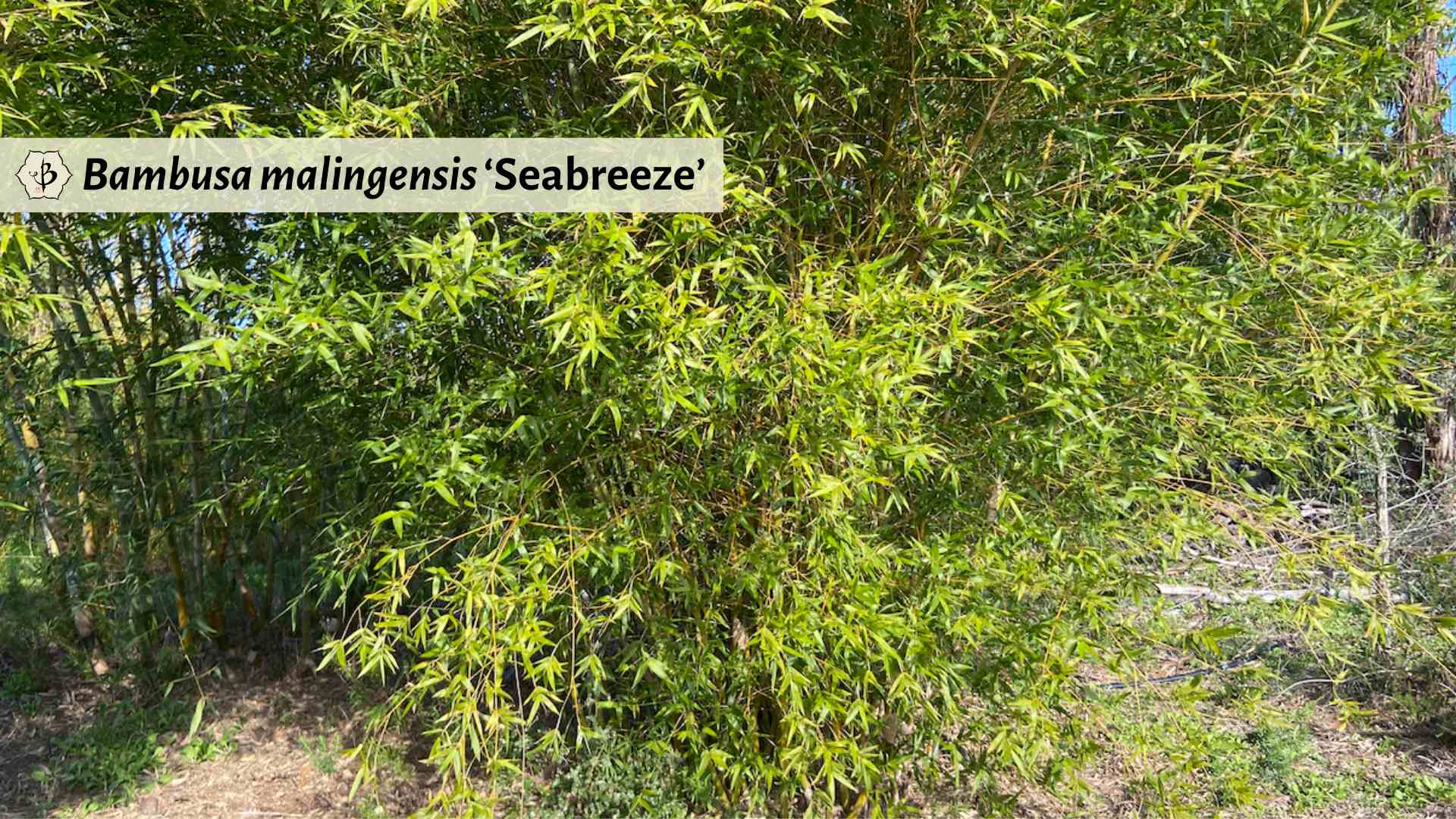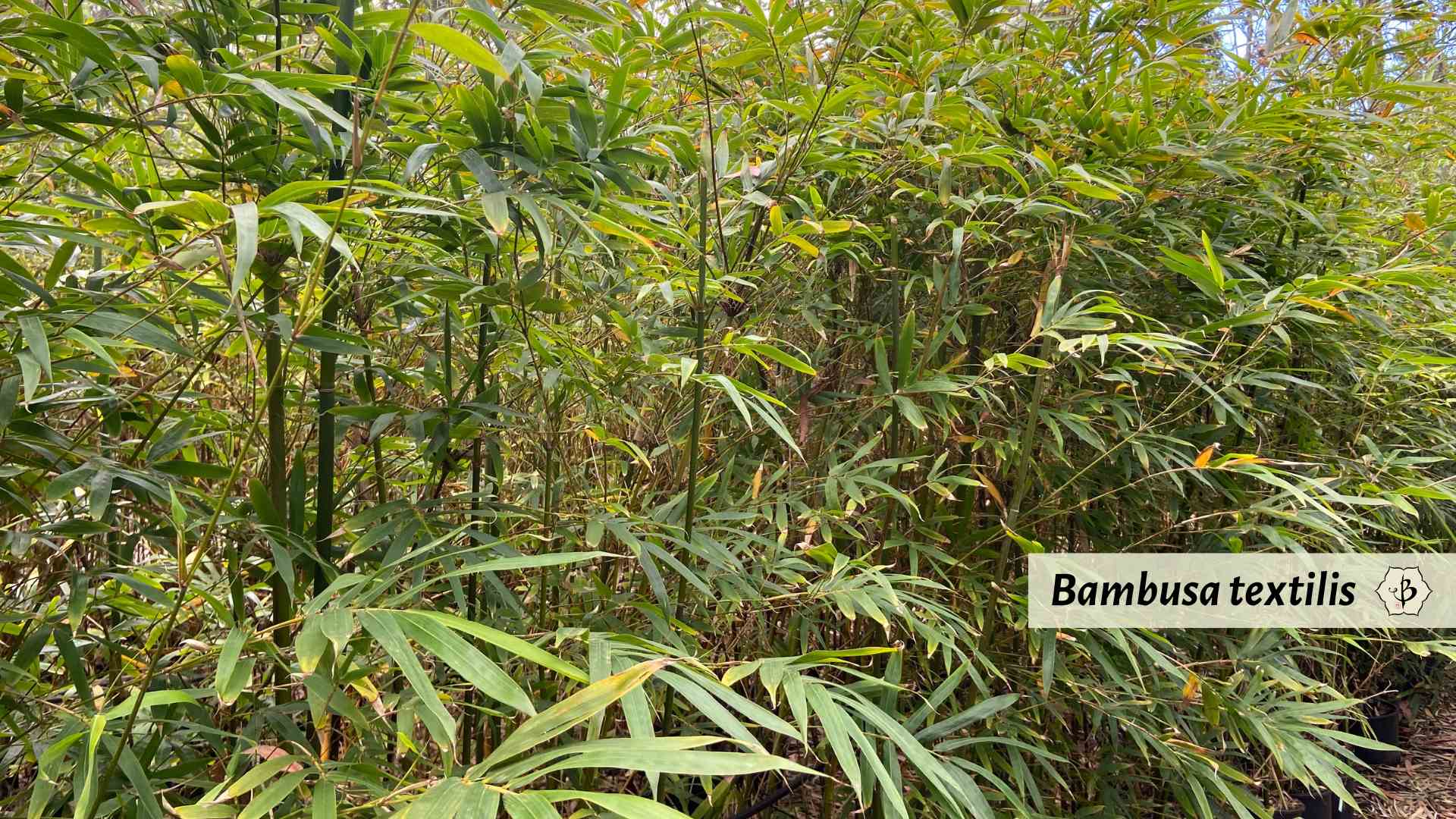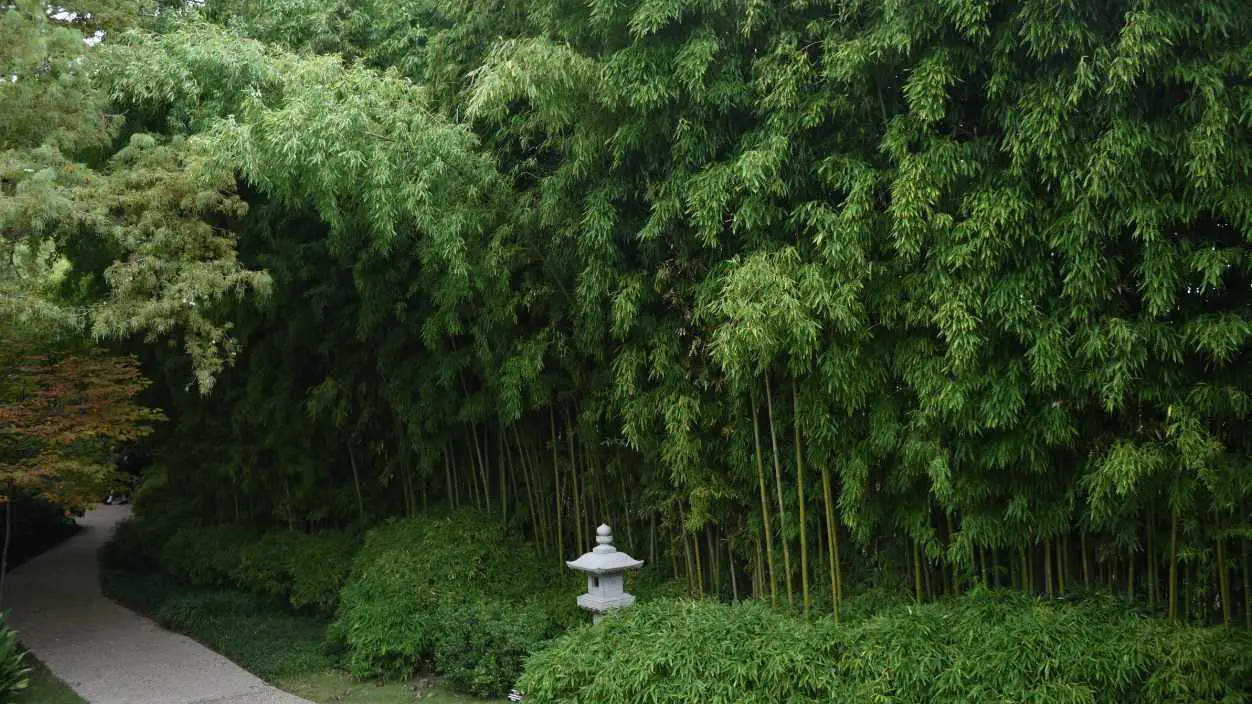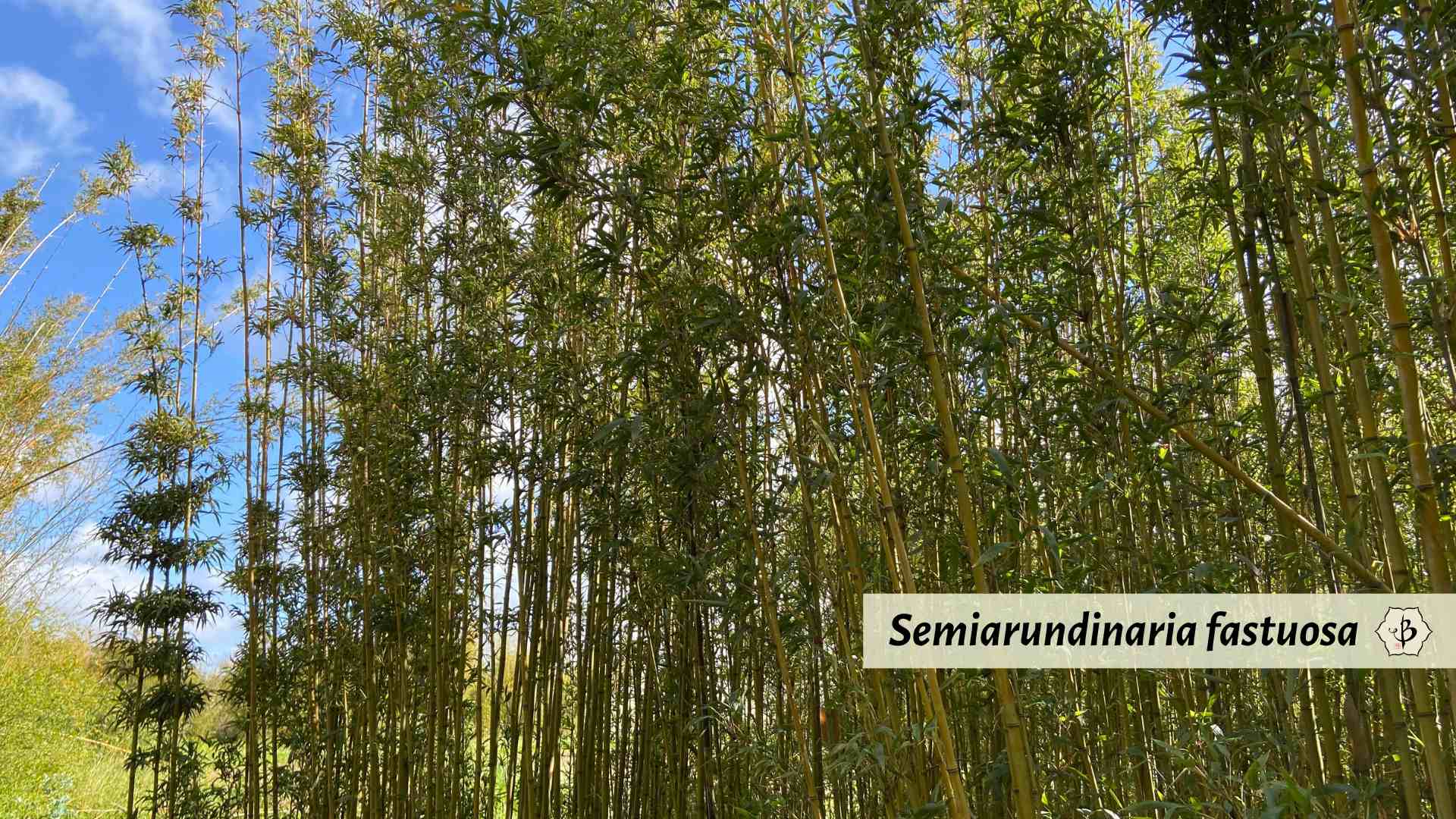One of the most common reasons for planting bamboo is to create a windbreak or a privacy screen. Bamboo is ideally suited for this because of its impressive height and its dense foliage. We sometimes refer to it as a living fence. But for this purpose, some bamboo species are more optimal than others. So what are the best varieties of bamboo to provide a good windbreak?
Bambusa malingensis, also known as Seabreeze Bamboo, makes for an excellent windbreak or privacy hedge. It’s a tightly clumping species that’s easy to contain, but also has thick greenery and sturdy culms that are wind-resistant. Culms typically grow 20 to 30 feet tall and up to about 2 inches thick. A subtropical species, Seabreeze Bamboo needs a warm climate, but it’s more tolerant of salty air and a range of moisture conditions. Bambusa multiplex, or Hedge Bamboo, is another popular choice, similar in size and appearance to Seabreeze.
NOTE: This article first appeared in June 2021 and was most recently updated in May 2024.

Seabreeze Bamboo: Bambusa malingensis
Most bamboo, besides the little dwarf varieties, is capable of providing a good windbreak. Bamboo is known for its ability to bend in the breeze. But some species grow more leaves and have more tightly clustered canes. Bambusa malingensis is one of those species that is perfect for sheltering your garden from the wind. That’s why it’s often called Seabreeze Bamboo, and in warmer climates, it’s one of the best choices of windbreak bamboo.
CHARACTERISTICS
This attractive species has tall, graceful culms that normally grow about 20 or 30 feet tall. Individual stalks are roughly 1.5 to 2 inches in diameter. They grow fairly straight and upright but may arch gently at the top. Tight clumps tend to fan out at the top, creating a cone-like shape with a majestic appearance. They are flexible enough to sway in the breeze and even withstand a tropical storm. It won’t be bothered by salty, coastal air, but can also thrive in a dry, inland climate.
Seabreeze Bamboo can tolerate the salty air, but growing in saline soil is another question. This is an area that probably requires more research, but if you’re trying to plant bamboo in salty terrain, you might try a sturdy species like Bambusa bambos or Dendrocalamus strictus.
Like all varieties of Bambusa, Seabreeze is a clumping bamboo, which means it won’t spread out and take over your yard the way some runners would. And even for a clumper, B. malingensis is unusually tight and compact. The canes grow close together, making the plant more resistant to the wind. And the profusion of leaves helps to block both the choppy weather and the eyes of nosey neighbors.

GROWING CONDITIONS
Because it’s a tight-clumping bamboo, a solitary Seabreeze can provide a nice centerpiece or focal point in a garden. But if you’re planting it as a windbreak, you’ll want to plant numerous specimens in a row. Use some kind of rhizome barrier or dig a trench around the planting area if you want to maintain a very orderly hedge. Allow at least two feet in width. These containment methods are more important with running bamboos, but they are also useful for keeping a row of clumpers looking straight and tidy.
Bambusa is a tropical or subtropical bamboo genus, so this species is not especially cold-hardy. It prefers tropic or subtropic climates. Unlike some tropical specimens, it can survive a freeze. But temperatures below 20º F will likely bring frost damage. It’s a very popular species in Florida and also in Southern California.
Seabreeze Bamboo will do best in USDA zones 8 through 11. In zone 7, where winters freezing is more common, the leaves and culms could die back. In this case, simply remove any damaged material, and cut back culms all the way to the ground. The roots will most likely survive, and new growth should appear in the spring.

CONSUMING SHOOTS & LEAVES
The fresh, tender shoots of Seabreeze Bamboo are edible and known for their sweetness. Always boil your bamboo shoots before consumption to remove any natural toxins. The leaves of this variety are also great for making bamboo tea. Tea can be made with hot or cold water and is perfectly safe for consumption.
Other windbreak bamboo options
Bambusa multiplex: Hedge Bamboo
A close relative of Seabreeze, Bambusa multiplex is another species with an apt nickname. The same properties that make B. malingensis a good windbreak make this species a perfect hedge. It has elegant, upright canes, about 20 or 30 feet high and around 2 inches thick. Numerous lateral branches, typical of Bambusa, are filled with leaves and create an effective privacy screen.
The typical species is less common than many of the subspecies of B. multiplex. Cultivars like ‘Alphonse Karr’ and ‘Gold Stripe’ are among the most popular ornamental varieties, with their distinctive and attractive variegation.

Other notable cultivars include ‘Riviereorum’ or Chinese Goddess, ‘Tiny Fern’ and ‘Rosa’. Some of these subspecies grow smaller than the true multiplex, so they may be less optimal for screens or windbreaks. But other features, like their striped culms and delicate foliage, make them beautiful additions to any bamboo lover’s collection.
‘Tiny Fern’ and ‘Tiny Fern Striped’ are actually dwarf cultivars of this species. They generally only grow a few feet tall. Their diminutive size makes for a lovely ground cover or low hedge, but not much of a windbreak.

Bambusa textilis
A close cousin to both Bambusa malingensis and Bambusa multiplex, Bambusa textilis is quite similar in size and appearance. Sometimes called Weaver’s Bamboo, its split fibers have been traditionally used for craft making. A subspecies, ‘Gracilis’ or Graceful Bamboo, is very popular as an ornamental. Tall, slender poles rise from a tight clump, spreading like a fountain and arching gently near the top.
To create a hedge, these bamboo varieties, as pictured above, can be pruned to the desired height, or slightly lower than the ultimate height. Topping the culms will promote more lateral branching. This has the effect of producing a dense hedge, thick with leaves and branches, to produce an effective privacy screen.
Bashania fargesii: Windbreak Bamboo
While there are dozens of bamboo varieties capable of providing shelter against the wind, this lesser-known species has actually earned the nickname of Windbreak Bamboo. Native to southern China and Indochina, this running bamboo is more cold-hardy than the subtropical Bambusas. It can tolerate temperatures well below freezing and will perform well in USDA zones 6 and 7.
The roots of Bashania fargesii are especially robust, and also quick to spread, so be careful. The canes are unusually strong and almost solid, comparable to Tonkin Bamboo (Pseudosasa amabilis), commonly used for fishing poles and other crafts. This combination of traits makes the plant exceptionally resilient against gusty winds.
Expect mature specimens to get 10 to 20 feet tall, depending on the growing conditions. Culms grow to 1 or 2 inches in diameter.

Phyllostachys and others
If you’re living in a cooler climate, where freezing winters and seasonal snow are the norms, then the Bambusa varieties probably won’t do well. You’ll be better off with some kind of Phyllostachys or Semiarundinaria. Take a look at some of our related articles, below.
If you’ve got the space for it, a majestic timber bamboo like Madake (Phyllostachys bambusoides) or Henon (Phyllostachys nigra ‘Henon’) can provide a beautiful layer of shelter and privacy.
If space is an issue, and you don’t have room for a timber bamboo, you might go with a more modestly-sized option. Temple Bamboo (Semiarundinaria fastuosa) is a very attractive variety with upright, tightly clustered culms and ample foliage.
Just remember that these temperate bamboos are runners, and as such, you’ll need to use a root barrier or other containment strategy to prevent the hedge from sprawling into other areas of your (or your neighbor’s) garden.

Broaden your knowledge
If you’re fond of Seabreeze Bamboo and interested in growing bamboo as a windbreak and for other purposes, check out some of these useful and informative articles.
- Best bamboo species for hedges and screens
- Clumping bamboos for colder climates
- Growing bamboo in the shade
- Bamboo for Japanese gardens
- Identifying bamboo species
FEATURE IMAGE: Bambusa malingensis is pruned to form a thick hedge. Photo by Fred Hornaday.


























Hi Fred. I would live to grow Seabreeze Malingensis here in Spain for its drought and wind tolerance predominantly… but can I find it for sale?! Wondering if you might be able to help.
You can purchase it from the Bambu Parque in Portugal. There’s also a big bamboo nursery around Seville.
Hi, Where could i get Seabreeze Malingensis in Lagos state Nigeria?
I don’t know any nurseries in Nigeria with this species. Good luck!
Hi Fred, thanks for all this wonderful information. I live in Northern California and am looking for Seabreeze or one of these options. If you could point us in the direction of a supplier nearby, I’d be most grateful. Thank you!
Check out Bamboo Sourcery in Sebastopol!